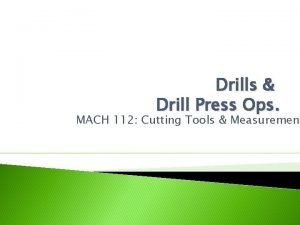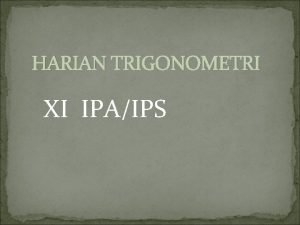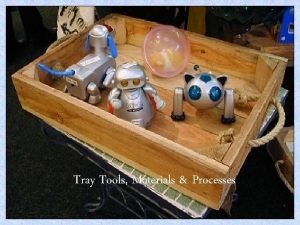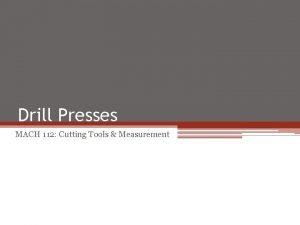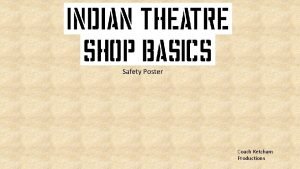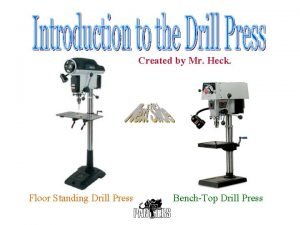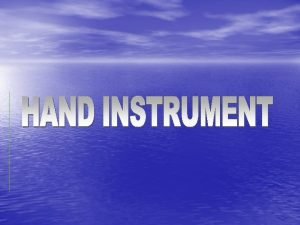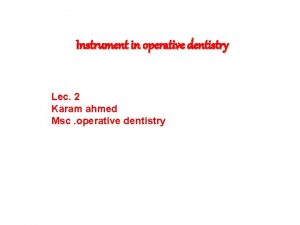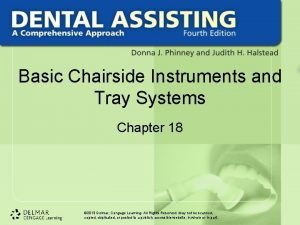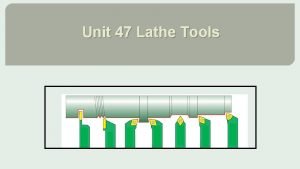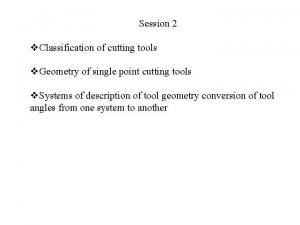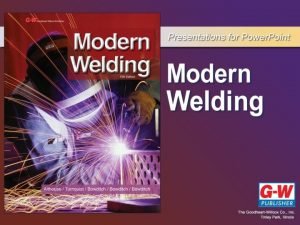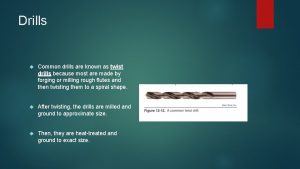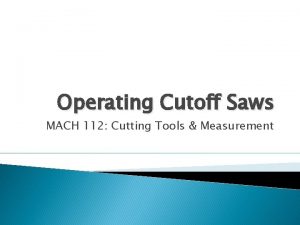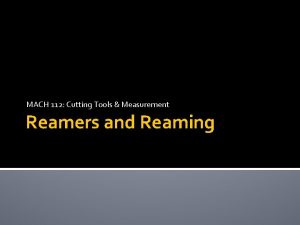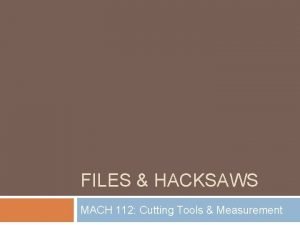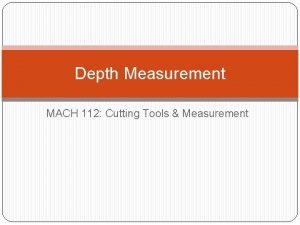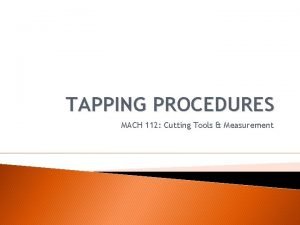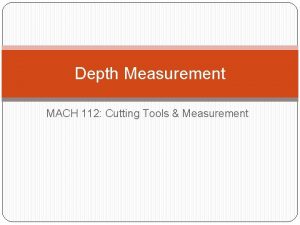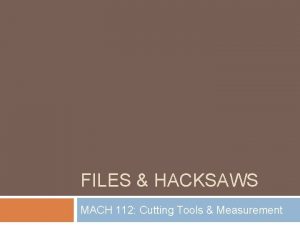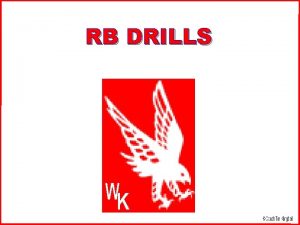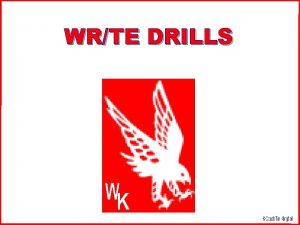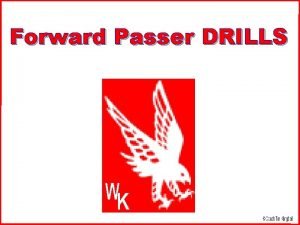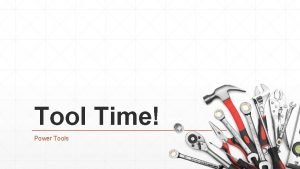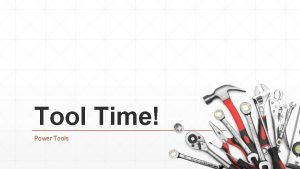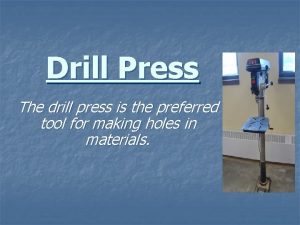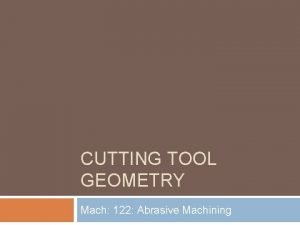Drills Drill Press Ops MACH 112 Cutting Tools


















- Slides: 18

Drills & Drill Press Ops. MACH 112: Cutting Tools & Measurement

OBJECTIVES After completing this unit, you should be able to… � Identify tools for drilling holes � Identify tools for countersinking and counterboring. � Select speeds and feeds for countersinking and counterboring. � Determine required hole sizes for c’bores & c’sinks

How a drill cuts

Parts of a Twist Drill Features of a twist drill (Besly Cutting Tools, Inc. ).

Drill Point Angles Long point for soft materials

Drill Types Spot Drill Oil-hole Drill Insert Drill Straight Fluted Drill Straight Flute Gun Drill Spade Drill Center Drill High Helix Drill

Drill Sizes � Numbers ◦ #80 to #1 (0. 0135 – 0. 228) � Letters ◦ A to Z (0. 234 – 0. 413) � Fractions ◦ 1/64 – 3 ½

Drilling Hints [ Examine drill before drilling [ Set correct RPM’s [ Check clearance above and below work piece [ Clamp work securely [ Always clean drill shank and machine taper before inserting drill [ Use shortest drill possible [ Always start each hole with a SPOT drill the hole [ Pay attention to the chips being produced ie. Shape and color [ Never force a drill if more pressure is required

Countersinks � � A countersink is a tool used to make a conical enlargement of the end of a hole. The included angles on commonly available countersinks are 60, 82, 90, and 100 degrees. ◦ Most flathead fasteners have an 82 -degree head angle ◦ In the aircraft industry, a 100 -degree angle is prevalent. � Cutting speed used when countersinking should always be slow enough to avoid chattering.

Counterbores � Counterbores are tools designed to enlarge previously drilled holes. ◦ They are guided into the hole by a pilot to ensure the concentricity of the two holes. ◦ They are often used to recess a bolt head below the surface of a workpiece. ◦ The diameter of the counterbore is usually 1/32” larger than the head of the bolt.

COUNTERSINKING AND COUNTERBORING Counterbores �A multiflute counterbore. Pilot MUST have clearance! Multiflute Counterbore. • A two-flute counterbore. Two-flute counterbore. Fig. H-101 The counterbore is an enlargement of a hole already drilled.

Counterbores � When a variety of counterbore & pilot sizes are necessary, a set of interchangeable pilot counterbores is available. Fig. H-102 Interchangeable pilot counterbore. Fig. H-103 Pilot for interchangeable pilot counterbore. Counterbores are made with straight or tapered shanks to be used in drill presses and milling machines.

COUNTERSINKING AND COUNTERBORING Counterboring Tips � For most counterboring operations the pilot should have 1/64”of clearance. ◦ If the pilot is too tight in the hole, it may seize & break. ◦ If there is too much clearance, the counterbore will be out of round & have an unsatisfactory surface finish. � The pilot must be lubricated while counterboring.

COUNTERSINKING AND COUNTERBORING Spotfacing � Counterbores or spotfacers are often used to provide a flat bearing surface for nut or bolt heads on rough castings or a raised boss. ◦ This operation is called spotfacing. Fig. H-104 Spotfacing on a raised boss.

Cutting Speeds � Speeds are half the speeds used for twist drills of corresponding diameters. � Choice of speeds & feeds is affected by condition of the equipment, power available & material being counterbored.

Calculating Sizes

Review � � � � What three included angles are found on drills? What drill point angle be used on hard material? Name four different types of drills How are English drill sizes identified? What are three most common angles found on c’sinks? How much clearance is normally allowed between a bolt and a c’bored hole? How much clearance is needed to accommodate the counterbore pilot? What is spotfacing?

QUESTIONS
 Bulk conical countersink
Bulk conical countersink Nilai dari 6 sin 112,50 sin 22,50 adalah …..
Nilai dari 6 sin 112,50 sin 22,50 adalah ….. Drill press tray
Drill press tray How are drill presses measured
How are drill presses measured Drill press safety poster
Drill press safety poster Drill press safety poster
Drill press safety poster Drilling machine mcq
Drilling machine mcq Lateral cutting instruments
Lateral cutting instruments Palm grasp in dentistry
Palm grasp in dentistry Chapter 18 basic chairside instruments and tray systems
Chapter 18 basic chairside instruments and tray systems Sewing tools measuring tools
Sewing tools measuring tools Flank wear
Flank wear Types of lathe cutting tools
Types of lathe cutting tools Cutting tools function
Cutting tools function Jigs and fixtures definition
Jigs and fixtures definition Two point cutting tool
Two point cutting tool Chapter 10 plasma arc cutting
Chapter 10 plasma arc cutting Wood work holding tools
Wood work holding tools Folding knife definition floral design
Folding knife definition floral design
